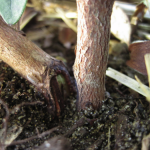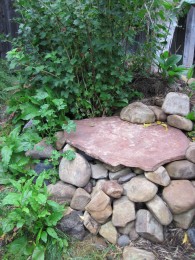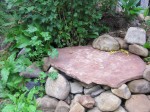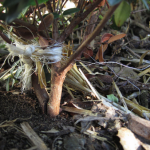Oct 222010

Garden Log:
- Fed Mexican lime, Kaffir lime, and Lemon Guava kitchen scraps before mulching with earthworm harvest, wood chips, granular spore, and a sprinkle of water.
- Chop and drop throughout the back garden.
-

Western Fence Lizard Liar with dock (left) and comfry (back right) grown for "chop and drop". Insects will come to eat the red currant berries (taller green plants alongside slate) and lizards from the rockpile habitat will feast on the insects.
Wood chip mulched Hister Beetle Huckleberry Habitat, apple and pear trees, and Sea Lion Splash’s kiwi vine.
- Harvested white clover mulch from under Norwegian Hill Basket to seed/mulch Salamander Redwood Lodge with white clover.
- Digging in SSSC’s Lower Chamber, slowly but surely. Lined waiting toilet tanks with cardboard over holes in bottom. Filled tanks with wood chip.
- Prepared 15 gallon tubs with layered alfalfa and clay from SSSC. Tubs stored near Earthworm Box and will be used to mix material into box contents. Also layered 15 gallon tubs under deck that wick water to jasmine and grape; top layer is adobe so rotting alfalfa does not stink too bad.
- Tied string around split trunk of huckleberry.
To you, the Habitat Gardener:
- About those 15 gallon nursery pots used to wick water (#6, above), that’s my solution to not having drip irrigation EVERYWHERE. Sure, everywhere would be most efficient, but I do wallow in procrastination at times. The wicking pots, also provide a place to make poor soil good soil, as the mulch breaks down AND it’s habitat. All that soil/clay/mulch/wood chips/water — you know there’s a multicultural neighborhood going in those pots.
- “Chop and Drop” (#2, above) is about carbon farming — plants grown for their ability to harness the sun’s energy and turn it into green leafage. Both the comfrey and the dock in your garden can be grown “as weeds”, leafing out wherever you want to build soil. The plant grows, you chop it down, NOT PULL IT OUT. That dock or comfrey plant will grow back, you will chop it again, Pete and repeat. The beauty of your labor will be making soil. As the plant grows, it will send out roots. Chop to ground level, and those roots die back AND, in the process of dieing back, leave organic matter in your soil. Not only has the plant busted its root down into the soil, but also it will leave some of the water and organic matter in it behind when the above-surface life is cut from it. And even better, the comfrey will also nitrogen fix the soil. In other words, the rhizomes clinging to the comfrey roots will release nitrogen into the soil when the root dies back. Emphasis on “when” there because most gardeners that grow comfrey as companion plants in their gardens don’t realize that significantly more nitrogen is released when the rhizome dies back. Chop to the ground, release nitrogen to the subsoil, mulch the surface with the nitrogen-rich leaves, and know that that comfrey plant will thrive again, to be chopped again. You might want to get to the comfrey before it goes to seed; controlling the rhizome spreading plant is challenging enough. Also note that the comfrey is a very medicinally useful plant. As for dock, the very young (inner) leaves are tasty raw by themselves and in salads. Don’t forget that mega salad you’ve got growing in the back of the garden, AKA “the compost pile” — dock greens are a great way to jumpstart the pile.
- For huckleberry trunk repair (#7, above), I used 1/2 of garden twine (knotted one end and split the string open) to create a thin strand that will decay by the time the plant is ready to bust loose from the bondage. I had thought that the huckleberry shrub was dying from a water issue but then found that the trunk was split during planting. Since planting this spring, the wound seems to have healed partially and the plant has bulked up — it’s going to live! The berries will be enjoyed by many critters, including me and the birds. Check out the pics to today’s repair job for that split huckleberry trunk below or at: BEFORE and AFTER.
- dock (left) and comfry (back right) grown for “chop and drop”
- Before
- After
Save a life (yes, plants count), enjoy a berry or two.
Tony


